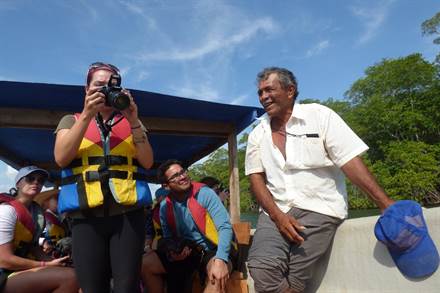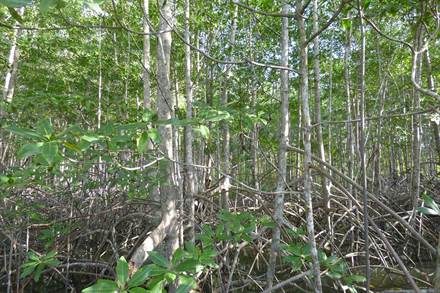
Up Close and Personal with the Mangroves
-
Conservación de humedales costeros
-
Resiliencia costera
I have been researching mangroves for months in preparation for this trip. I thought I knew all about the mangroves and their benefits. However, landing in David changed my perspective. After today, mangroves are not just an object of research, but real, tangible plants. Mangroves are stunningly beautiful, and in all my research I had not come across an article detailing their beauty. Mangroves are referred to as gentle giants for their grace in and out of the water, and for the protection they provide for the villages. I am grateful for the chance to see these majestic mangroves up close and personal.

Our group went to Santa Cruz, which means “the holy cross” in English. Specifically, we went to Port Pinzones to meet with local fisherman. The fishermen took us on a boat tour of the mangroves. We were in a large estuary, where fresh and salt water meet. What shocked me most is learning that there are 11 species of mangroves since I had not encountered this fact in my research.

On the tour we encountered several of these species. For one, we saw the “Twister” mangrove, which gets it’s name from the twisted, strong roots. Next we saw the piedra gosa (rock mangrove), which is predominately formed from rocks. We also encountered the red mangroves, which receives the name from the red tips of the roots. The red mangroves also have strangely shaped roots and are the thickest mangroves, which allows them to store more carbon to help minimize the effects of climate change. If a red mangrove is cut down or burned, the carbon stored in it is released into the atmosphere as carbon dioxide, a greenhouse gas, contributing to climate change. Red mangroves also are closest to the oceans because they grow best in salty water. We also encountered the piñuelo mangrove, known for it’s narrow leaves, and the boca santa (scared mouth) mangrove, which has no reason for the name. Finally, we saw the black mangrove, known for the flowers it produces. Another interesting characteristic of mangroves is that the roots grow in the direction of the current, which is why many lean.
In addition to the different mangrove species, we learned that there are several animal species living among the mangroves. Birds, monkeys, iguanas, fish and shellfish live among the mangroves. Additionally, the waters are home to several large crocodiles, which can be as long as 18 feet. The fishermen told us that the mangroves provide food for the village. They use nets in shallow and deep water to catch different types of fish. The red snapper is very common, and is often exported to the United States. Also I learned the lower mangroves produce the most clams for the village to eat, especially in the dry season.

During the tour we were able to interview the fishermen about their views of the mangroves, and why the mangroves are important to them. We learned that mangroves are property of Panama. The fishermen feel they have no authority or resources to help bring awareness and better protect the mangroves. They cited trash and a disrespect of the mangroves and the village culture as the two main threats putting mangroves in danger. They hope to bring more awareness to these problems through tourism, in addition to bringing in more income to sustain the village.
Overall today was everything I could have imagined and more. I could research about mangroves for the rest of my life, but I would have never understood them until I saw them today. The mangroves are real, they are in danger, and they need our help to spread the message. Protect the mangroves, because they protect us.
These are entries by students from Texas Christian University (Fort Worth, TX, USA) Roxo students traveling to Panama for Spring Break to work with Wetlands International on the Mangrove Project.
